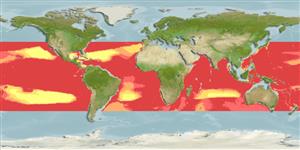>
Lophiiformes (Anglerfishes) >
Centrophrynidae (Prickly Seadevils)
Etymology: Centrophryne: Greek, kentron and Latin, centrum = prickle or spine (in addition to the midpoint of a circle ) + Greek, phryne = toad, prickly toad (Ref. 86949).
More on authors: Regan & Trewavas.
Environment: milieu / climate zone / depth range / distribution range
Ecologie
marien bathypelagisch; diepte 590 - 2325 m (Ref. 86949). Deep-water; 40°N - 43°S, 180°W - 180°E
Tropical and subtropical parts of all oceans. Eastern Atlantic: single record at 18°58'S, 10°14'W. North-eastern Atlantic: single record at 30°45'N, 14°30'W.
Grootte / Gewicht / Leeftijd
Maturity: Lm ? range ? - ? cm
Max length : 1.3 cm SL mannelijk / geslacht onbekend; (Ref. 86949); 24.7 cm SL (female)
Dorsale zachte stralen (totaal): 6-7; Anale zachte stralen: 5 - 6. Distinguishing characteristics: larvae and juvenile with small digitiform hyoid barbel. Metamorphosed females: with single oval-shaped ovary; presence of supraethamoid; frontals are narrowly separated by cartilage along dorsal midline, each without ventromedial extension; presence of parietals, pterosphenoids, metapterygoids and mesopterygoids; absence of sphenotic spines; hyomandibula with double head; 2 hypohyals and 6(2+4) branchiostegal rays; bifurcated opercle; dorsal fork, short and less than 50% the length of ventral fork; long and slender subopercle with slender tapering upper end; well developed spine on anterior margin of lower end of subopercle; quadrate and articular spines present but minute; absence of angular and preopercular spines; jaws equal anteriorly, lower jaw with well-developed symphysial spine; absence of postmaxillary process of premaxilla; long and well developed anterior-maxillomandibular ligament; first pharyngobranchial present and suspensory in function; well-developed and toothed second and third pharyngobranchial; fourth pharyngobranchial absent; well ossified first, second and third hypobranchials, single ossified basibranchial; first epibranchial and all four ceratobranchials with teeth present; epurals absent; hypural plate deeply notched posteriorly; pterygiophore of illicium bears small ossified remnant of second cephalic spine; escal bulb contains central lumen with an escal pore leading to the exterior; tooth like denticles absent in esca; absence of posteroventral process of coracoid; presence of four pectoral radials, fusing to 3 in specimens greater than 150mm; pelvic bones present, slightly expanded distally; caudal rays 9 (2 simple+4 bifurcated+3 simple); numerous , close-set dermal spinules covering skin; pyloric caeca absent. Males: short hyoid barbel behind symphysis of lower jaw; small eyes, each without an aphakic space; relatively large olfactory organs; triangular shape of upper denticular plate, bearing a transverse series of 3 well-developed hooked denticles; crescent shaped lower denticular plate bearing transverse series of 4 strong, symmetrically placed denticles, fused at base; skin is naked, absence of dermal spinules. Larvae: short and deep; moderately inflated skin; short, digitiform hyoid barbel; moderate size of pectoral fins, not reaching base of dorsal and anal fins; pelvic fins absent (Ref. 086949).
Also mesopelagic. Males dwarfed, non-parasitic (Ref. 4493). 25 records from all oceans (Ref. 36124).
Levenscyclus en paargedrag
Maturiteit | Voortplanting | Paaien | Eieren | Fecunditeit | Larven
Bertelsen, E., 1990. Centrophrynidae. p. 509. In J.C. Quero, J.C. Hureau, C. Karrer, A. Post and L. Saldanha (eds.) Check-list of the fishes of the eastern tropical Atlantic (CLOFETA). JNICT, Lisbon; SEI, Paris; and UNESCO, Paris. Vol. 1. (Ref. 4493)
Status op de Rode Lijst van het IUCN (Ref. 130435)
Gevaar voor de mens
Harmless
Gebruik door de mens
Meer informatie
Lokale namenSynoniemenMetabolismePredatorenEcotoxicologieVoortplantingMaturiteitPaaienPaaiaggregatiesFecunditeitEierenOntwikkeling van de eieren
ReferentiesAquacultuurAquacultuurprofielKweeklijnenGeneticaElectrophoresesErfelijkheidZiektesVerwerkingNutrientsMassaconversie
Tools
Speciale rapporten
Download XML
Internetbronnen
Estimates based on models
Preferred temperature (Ref.
123201): 3.5 - 6.9, mean 4.7 °C (based on 976 cells).
Fylogenetische diversiteitsindex (Ref.
82804): PD
50 = 1.5000 [Uniqueness, from 0.5 = low to 2.0 = high].
Bayesian length-weight: a=0.01000 (0.00244 - 0.04107), b=3.04 (2.81 - 3.27), in cm total length, based on all LWR estimates for this body shape (Ref.
93245).
Trofisch niveau (Ref.
69278): 4.1 ±0.7 se; based on size and trophs of closest relatives
Fishing Vulnerability (Ref.
59153): Low vulnerability (20 of 100).
